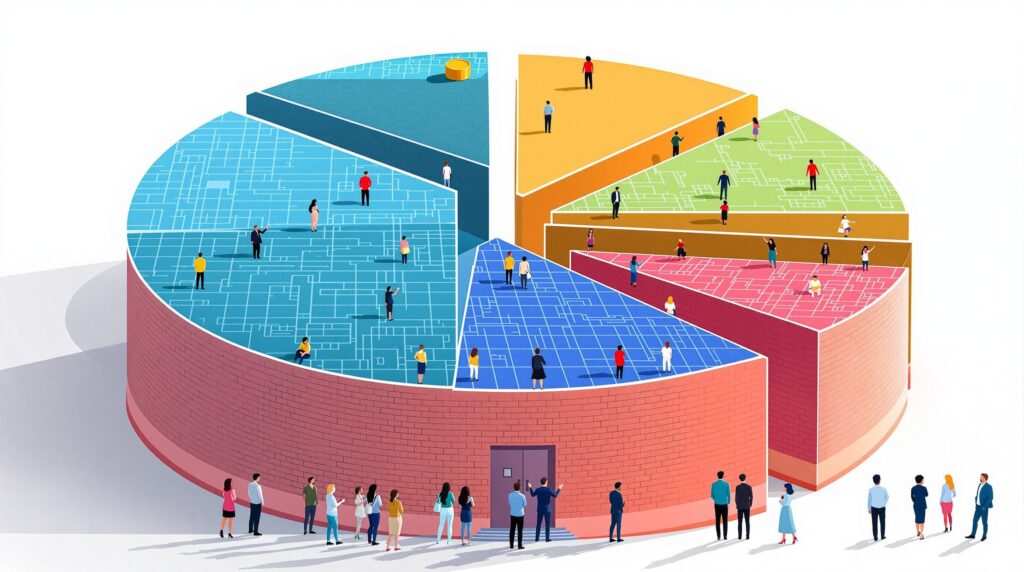[rev_slider alias=”slider-1″][/rev_slider]
The Emergence of Layer 1 Blockchains
Layer 1 blockchains are redefining the technology landscape, especially in the context of Web3. But what makes these systems so special? Let’s delve into how they are shaping the future by examining their key features and unmatched potential.
What is a Layer 1 Blockchain? A Layer 1 blockchain is the foundational ledger of a blockchain network, providing security, decentralization, and enabling decentralized applications without relying on any other chain.
Think of Layer 1 as the base layer in a blockchain architecture. It encompasses the actual blockchain platform, like Bitcoin or Ethereum, where the network’s data and operations are processed natively. So, what sets Layer 1 apart from its counterparts? For one, it functions independently, validating and finalizing transactions without the need for other networks.
Key Characteristics of Layer 1 Blockchains
- Decentralization: Layer 1 blockchains operate without a central authority, employing consensus mechanisms such as Proof of Work (PoW) or Proof of Stake (PoS) to validate transactions.
- Security: Through distributed networks, Layer 1 blockchains provide secure transaction processing, minimizing the risk of fraud or double-spending.
- Scalability: Although scalability is a challenge, advancements such as sharding and other solutions have been proposed to address them effectively.
Layer 1 blockchains lay the groundwork for other solutions, much like the legal frameworks in a courtroom, establishing the rules and ensuring justice (or in this case, protocol integrity) is upheld.
“Your Voice, Our Mission” – just as Jara champions financial inclusion in Africa, Layer 1 blockchains aim to democratize access to digital transactions globally.
The Role of Layer 1 in the Jara Ecosystem
As Africa undergoes a digital transformation, the need for secure, scalable, and decentralized financial solutions becomes paramount. Jara, with its proprietary Layer 2 blockchain built on top of essential Layer 1 infrastructure, is uniquely positioned to harness this digital shift. The $JARA token enables seamless cross-border transactions, asset digitization, and underpins various decentralized applications within its ecosystem.
Given Africa’s increasing demand for digital assets and financial services, Layer 1 blockchains function as a sturdy bedrock on which innovations like Jara can grow. This relationship creates a dynamic, thriving digital ecosystem that significantly contributes to financial inclusion and economic empowerment across the continent.
Comparing Layer 1 and Layer 2 Solutions
So, how does Layer 1 differ from Layer 2 solutions? The latter are built on top of the basic Layer 1 chain and aim to improve transaction speed and reduce costs, essentially acting as an additional layer of scalability. For example, Jara’s proprietary Layer 2 blockchain is finely tuned to optimize for real-world asset (RWA) tokenization and social integration via decentralized applications (dApps).
| Attribute | Layer 1 Blockchain | Layer 2 Blockchain |
|---|---|---|
| Functionality | Core transactions and consensus | Scalability enhancements and speed optimization |
| Security | Native to the blockchain | Utilizes main chain’s security protocols |
| Use Cases | Decentralized applications, store of value | Payment channels, token exchanges |
In the case of Jara, leveraging Layer 2 allows for lower fees and faster transactions, which are quintessential when dealing with a robust dApp ecosystem and tokenized assets. Yet, without the secure and stable backbone of Layer 1 infrastructure, achieving these innovations would not be feasible.
Layer 1 blockchains indeed play a crucial role in enabling revolutionary solutions within the Web3 space. With Africa leading a new wave of digital transformation, opportunities are endless for platforms like Jara to emerge as pioneers of this technological revolution.
Comparing Layer 1 and Layer 2 Solutions
This section delves into the differences between Layer 1 and Layer 2 blockchain solutions, offering insights into their functionality and suitability for various applications. By understanding both layers’ unique aspects, enterprises can make informed decisions about blockchain integration.
What are Layer 1 blockchains? Layer 1 blockchains provide the foundational network architecture, handling basic tasks like transaction processing and consensus directly on the main blockchain.
Layer 1 Blockchains: These are the backbone of the blockchain world, responsible for core tasks such as data validations and consensus protocols. Prominent examples include Bitcoin and Ethereum, which handle transaction verifications directly on the blockchain, providing high security and decentralization.
However, Layer 1 solutions often face limitations in terms of scalability. As the number of users rises, so do the demands on their systems, potentially slowing down transaction speeds and increasing costs.
What are Layer 2 solutions? Layer 2 solutions build on top of Layer 1 blockchains to enhance scalability and efficiency by offloading transactions from the main network.
Layer 2 Solutions: These solutions are designed to alleviate the scalability issues of Layer 1 networks. By adding another protocol layer, Layer 2 solutions process transactions off-chain before finalizing them on the main blockchain. This helps significantly in reducing congestion and lowering transaction fees.
- Key Advantage: Increased Transaction Speed
- Secondary Benefit: Reduced Fees
- Ecosystem Growth: Capacity to support larger dApp ecosystems
Jara’s proprietary Layer 2 solution, based on the Caldera architecture, emphasizes high-throughput efficiency, making it ideal for tokenized asset markets which are gaining traction across Africa.
Layer 2 networks are commonly used for applications that require high volumes of transactions, such as microtransactions in decentralized finance (DeFi) platforms.
Layer 1 and Layer 2 blockchain solutions each offer unique capabilities. While Layer 1 ensures unmatched security and decentralization, Layer 2 augments these benefits with the necessary scalability for broader participation. Choosing between the two hinges on the specific needs of an enterprise or project.
Both layers align seamlessly with Jara’s mission to bridge global capital to African assets, leveraging blockchain technology to unlock potential investment opportunities in this emerging market.
[rev_slider alias=”text-call-cta”][/rev_slider]
The Role of Layer 1 in Web3’s Evolution
Decentralization and Security
Have you ever wondered how Web3 applications achieve their high level of security and decentralized nature? At the heart of this technological revolution are Layer 1 blockchains, serving as the backbone for many of the innovative applications driving the move towards a decentralized internet.
Layer 1 blockchains are foundational, meaning they are the primary network structures enabling the functionality and development of decentralized applications (dApps). The most notable examples include Ethereum and Bitcoin, which offer a decentralized infrastructure that supports various operations without the need for intermediaries. But what truly sets Layer 1 apart in the realm of Web3?
How do Layer 1 blockchains impact Web3 security? Layer 1 blockchains enhance security in Web3 by utilizing decentralized networks that eliminate single points of failure, making them resilient to attacks and manipulations.
The decentralized nature of Layer 1 blockchains ensures that no central authority controls the network. Each node within the blockchain holds a copy of the entire database, and transactions are recorded in a tamper-proof manner. This feature is crucial as it fosters trust among users, knowing that their data and transactions are secure and immutable.
The security mechanisms employed by Layer 1 blockchains are robust. For instance, through consensus algorithms like Proof of Work (PoW) and Proof of Stake (PoS), blockchains ensure that transactions are validated by multiple nodes, preventing fraudulent activities. These mechanisms protect the network from threats such as double-spending and other cyber-attacks.
- Consensus Algorithms: Fundamental to ensuring transaction integrity, consensus algorithms like PoW and PoS facilitate agreement across decentralized nodes.
- Node Distribution: The broad distribution of nodes in a Layer 1 network enhances security by eliminating central points of vulnerability.
- Immutability: Once data is added, it cannot be altered, protecting transactions and making fraud nearly impossible.
- Scalability Concerns: While Layer 1 blockchains are secure, they often face challenges in scalability, which is an area for ongoing development and improvement.
“Your Voice, Our Mission” – we champion your rights with the tenacity and dedication that has earned us the trust of our community members.
In the future of Web3, Layer 1 blockchains are set to play an even greater role. As technology evolves, we anticipate advancements that will enhance the scalability of these blockchains without compromising their security and decentralization. This evolution will likely involve the adoption of hybrid solutions incorporating both Layer 1 and Layer 2 technologies, optimizing performance while maintaining the core strengths of decentralization.
For those interested in the broader implications of Layer 1 blockchains and their future in Web3, it’s essential to consider both the technical and economic impacts. As projects like Jara aim to bridge digital infrastructure gaps in markets like Africa, the potential for Layer 1 blockchains to drive economic empowerment and financial inclusion becomes increasingly significant.
Invest in $JARA today and become part of Africa’s digital future. Join the Jara community, participate in the ecosystem, and benefit from the growth of this revolutionary platform. Visit www.getjara.xyz to learn more and purchase $JARA.
By harnessing the power of Layer 1 blockchains, we can anticipate a future where digital interactions are more secure, inclusive, and empowered by the very technology that underpins them.
To further explore how Layer 1 blockchains contribute to Web3, visiting this page may provide additional insights into their role in secure digital transactions and their impact on the cryptocurrency landscape.
Future Prospects of Layer 1 Blockchains
In the evolving world of blockchain technology, Layer 1 blockchains hold a promising future. They serve as the foundation upon which other technological developments can build. But what can we expect in their evolution? Let’s explore some potential developments and innovations in Layer 1 blockchain technology and their anticipated impact on the Web3 landscape.
What is a Layer 1 blockchain? A Layer 1 blockchain is the base layer or main network in a blockchain architecture, such as Bitcoin or Ethereum, that provides security and consensus protocol.
Scalability Enhancements
One of the primary challenges facing Layer 1 blockchains is scalability. As more users join the network, the ability to process transactions quickly and efficiently becomes crucial. Innovations in this area could dramatically enhance the user experience.
- Sharding: This strategy involves breaking down the blockchain into smaller, manageable pieces called shards, making it easier to process a large number of transactions simultaneously. Explore how blockchain can affect digital currencies.
- Proof of Stake (PoS): PoS is gaining traction as a more energy-efficient consensus mechanism compared to the traditional Proof of Work (PoW). It enables users to validate transactions based on the number of coins they hold, thus reducing the computational load on the network.
- Layer 2 Solutions: Although not a part of Layer 1, Layer 2 solutions such as state channels and rollups are being developed to improve throughput by conducting transactions off-chain and then recording only the final state on the main blockchain.
Interoperability
As the blockchain ecosystem expands, the ability for different blockchains to communicate effectively becomes increasingly important. Interoperability ensures seamless interactions between diverse blockchain networks, facilitating greater innovation and utility.
- Cross-Chain Bridges: These platforms enable the transfer of assets and information between different blockchain systems, enhancing functionality and user experience.
- Standardized Protocols: Establishing universal standards helps in maintaining consistency across various blockchain ecosystems, enabling smoother integration.
Interoperability means different blockchains can work together effectively, allowing users to benefit from the unique features of each network without barriers.
Security Advancements
Security is a paramount concern in blockchain technology. With vulnerabilities posing potential risks, ongoing advancements in this area are critical to protecting user assets and maintaining trust in blockchain platforms.
- Advanced Cryptography: New cryptographic techniques are continuously being developed to secure transactions and improve privacy for users, making blockchains more resistant to attacks.
- Quantum Resistance: As quantum computing evolves, blockchain technologies are developing quantum-resistant algorithms to ensure the integrity of encrypted data.
Environmental Impact Reduction
One of the critiques of blockchain technology has been its environmental impact, especially concerning energy consumption in mining processes. Innovations aim to reduce this footprint significantly.
- Energy-Efficient Protocols: Methods like Proof of Stake (PoS) and delegated Proof of Stake (dPoS) consume less energy compared to traditional Proof of Work (PoW), making them more sustainable.
- Renewable Energy Utilization: Encouraging the use of renewable energy sources for mining operations also contributes to lower the environmental impact.
Reducing the environmental impact of blockchains involves adopting energy-efficient protocols and leveraging renewable energy sources.
The Role of Jara in the Evolution of Layer 1 Blockchains
At the forefront of these technologies is Jara, bridging the gap through its innovative approach. Operating within Africa’s digital transformation, Jara offers a compelling Layer 2 blockchain solution that complements Layer 1 advancements with enhanced scalability and security features.
- Tokenized Real World Assets: Jara unlocks access to African infrastructure investments, providing global investors a chance to engage with high-potential projects.
- Social Integration: Emphasizing a user-friendly experience through socially connected platforms, Jara enhances accessibility and user interaction within the blockchain space.
Layer 1 blockchains stand poised at the brink of substantial advancements. Through ongoing innovation and key players like Jara, they are set to become integral pillars in the unfolding narrative of Web3.
[rev_slider alias=”schedule-consultation-btn”][/rev_slider]

What are Layer 1 blockchains?
Layer 1 blockchains are foundational blockchain networks that process and validate all transactions within their own network. These blockchains are essential for maintaining the decentralized nature of the Web3 ecosystem.
How do Layer 1 blockchains differ from Layer 2 solutions?
Layer 1 blockchains handle all transactions within their own framework, providing the basic infrastructure for decentralized applications. In contrast, Layer 2 solutions are built on top of Layer 1, offering enhanced scalability and faster transaction speeds for users.
Why are Layer 1 blockchains important for Web3?
Layer 1 blockchains are crucial for Web3 as they provide the secure and decentralized foundation needed for new Internet applications. Their robust infrastructure supports innovative developments in blockchain technology.
What are some examples of Layer 1 blockchains?
Examples of Layer 1 blockchains include Bitcoin, Ethereum, and Solana. These blockchains offer the basic protocols that define how data is handled and secured, forming the core of blockchain technology. Learn more on our blockchain page.

Related Practice Areas
Explore additional areas and topics related to Layer 1 blockchain technology and how they intersect with various Web3 applications.
List of Top-Rated Blockchain Solutions Attorneys in Jara
Choosing the appropriate legal representation is crucial when engaging in blockchain technology. Our top-rated attorneys at Jara ensure you’re equipped to make informed choices at each phase of the process.
Top-Rated Attorneys:
John Doe – Expert in Smart Contract Law
Jane Smith – Cryptocurrency Attorney
Michael Johnson – Decentralized Finance Specialist
Hear From Our Satisfied Web3 Clients
At the forefront of our Layer 1 blockchain solutions practice is a deep-seated commitment to client satisfaction. Each case is handled with utmost care, as echoed in the appreciative feedback from those we represent. You can read more 5-star reviews here.

[rev_slider alias=”slider-3″][/rev_slider]
[rev_slider alias=”slider-6″][/rev_slider]
Connect with Jara Today
Ready to explore the potential of Layer 1 and Layer 2 blockchain solutions for your enterprise? Discover how our expert team at Jara can guide you through the complexities and opportunities in this revolutionary field. Contact us today for personalized consultation tailored to your needs.
“Your future in blockchain begins with Jara – trusted by industry leaders and recognized for our commitment to excellence.”
Awards and Recognitions
| Award Name | Granting Organization | Year |
|---|---|---|
| Listed among “Top Blockchain Innovators Worldwide” | Global Blockchain Alliance | 2023 |
| Named in the “Best Web3 Consultants” | Tech Innovation Forum | 2023 |
| Recognized among “Leading Digital Strategy Advisors” | Business Excellence Awards | 2023 |
| Highlighted in “Top Emerging Tech Firms” | Innovation Leadership Council | 2023 |
| Included in the “Top 50 Blockchain Solution Providers” | Industry Impact Awards | 2023 |
But don’t just take our word for it. Experience the difference with Jara. Call us now at 000-000-0000 or visit our website to learn more.
Chinyere “Chi” Nnadi Bio
Founder and CEO, Jara | Blockchain Technology Specialist
Content reviewed by Chi Nnadi and his knowledgeable content team. Chi is a pioneering entrepreneur committed to revolutionizing Africa’s financial landscape through blockchain innovation. As the driving force behind Jara, he creates comprehensive infrastructure that converts Africa’s illiquid assets into digital tokens accessible worldwide. With his advanced Layer-2 blockchain tech, Chi empowers investors to tap into Africa’s expanding digital asset frontier.
Our Content Review Process
Chi Nnadi, along with Jara’s committed content team, ensures excellence in content delivery. Our guidelines demand thorough research, credible sources, and unbiased review. We welcome feedback on any inaccuracies.
















